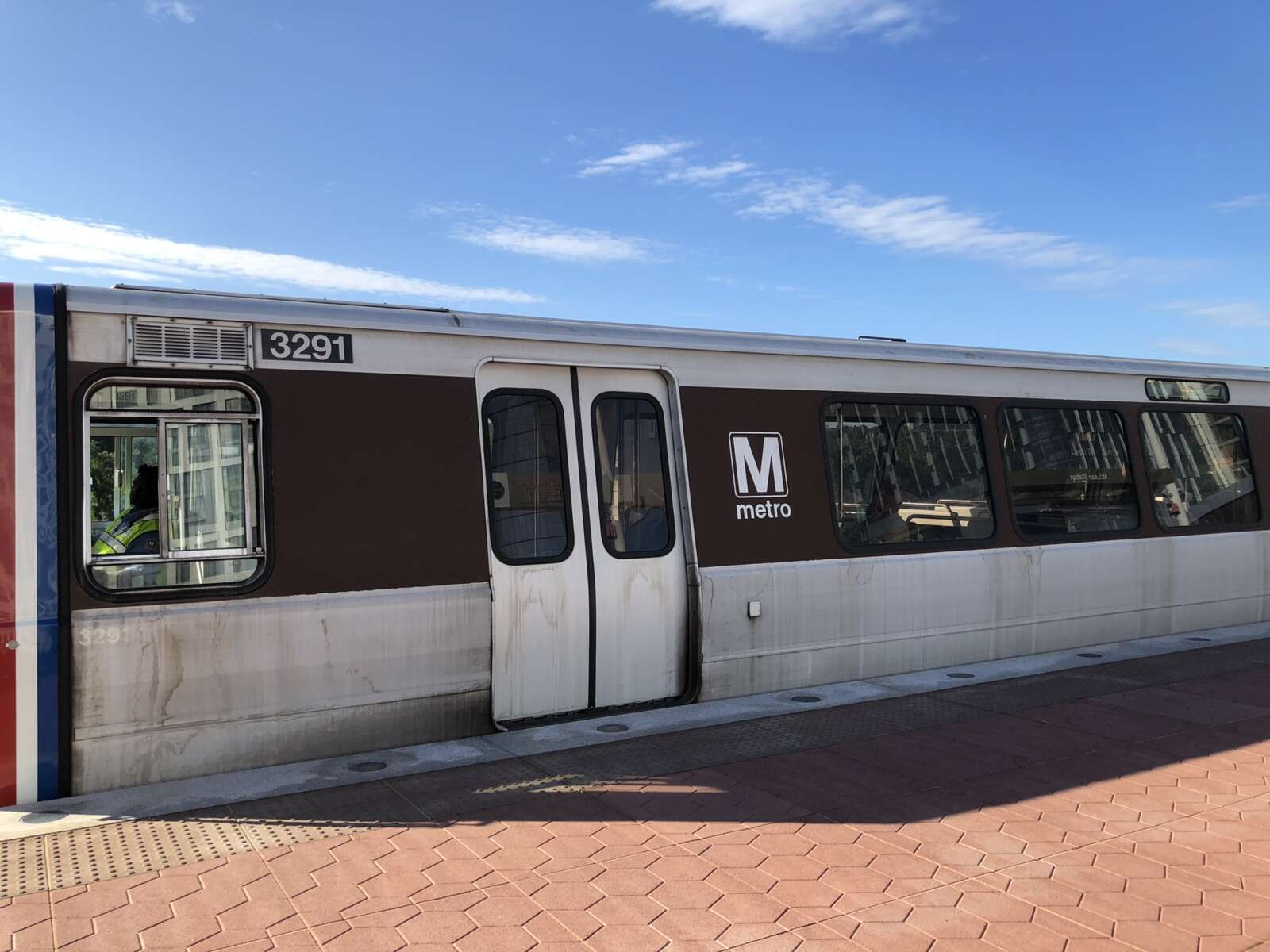
The Fairfax County Board of Supervisors is asking the county’s General Assembly delegation to oppose Gov. Glenn Youngkin’s proposed funding cuts to Metro in the state’s budget.
During a board meeting on Tuesday (April 16), supervisors unanimously approved a letter written by Chairman Jeff McKay, Braddock District Supervisor James Walkinshaw, and Dranesville District Supervisor James Bierman, asking the delegation to oppose the cuts and retain the funding needed to address the Washington Metropolitan Area Transit Authority’s (WMATA) estimated $750 million shortfall.
The General Assembly passed the FY 2024-2026 biennium budget in March which included $149.5 million from the state to address WMATA’s funding shortage in FY 2025 and FY 2026, according to the letter.
“This funding, which is expected to be matched by the local funding partners, including Fairfax County, is essential to putting WMATA on sound financial footing and retaining its consistent operations.”
A month later, Youngkin announced his proposed budget amendments, which included cutting $113.8 million of WMATA’s funding. Instead, Youngkin urged localities to use funds previously allocated to them through state assistance.
However, the county clarified in its letter that this money — provided to the region through the Northern Virginia Transportation Commission (NVTC) by the Northam Administration in 2022 — was used to cover immediate Metro payments following the pandemic and to reserve the remainder for “ongoing needs.”
Even with the additional funding, the letter says the county expects the money from the NVTC to be largely depleted soon, making their request even more vital.
“We know WMATA is absolutely essential to our regional economy,” McKay said during Tuesday’s County Board meeting. “It is essential to Virginia’s economy, bringing in over $1 billion a year into the general fund.”
He also noted how the lack of funding could impact taxpayers.
“If this money doesn’t come from the state, where will it come from? From the real estate taxpayers of Fairfax County. That’s where it will come from,” McKay said.
Springfield District Supervisor Pat Herrity said he was reluctantly supporting the request, saying Metro needed to “figure out how they’re going to get their costs under control.”
“We’ve got to get the long-term answer figured out because, you know, punting it down the road with a couple more years of ridiculous funding increases is not necessarily the best answer,” Herrity said.
Citing a 2017 study by former U.S. Department of Transportation Secretary Ray LaHood, Walkinshaw noted that Metro would need $500 million a year in dedicated funding to achieve stable financial footing, a burden that would ultimately fall on resident taxpayers.
“This idea that there are hundreds of millions of dollars or billions of dollars of cost savings to be found at Metro is a fantasy,” he said. “The amount needed in dedicated funding to prevent us from having to go back to property taxpayers every single year is in the hundreds of millions of dollars. That’s just math.”

A planned 14-gate concourse at Dulles International Airport received a major federal lift this week.
Yesterday, Senators Mark Warner and Tim Kaine announced that the Tier 2 Concourse East project will get $35 million in funding from the Bipartisan Infrastructure Law that Congress passed in 2021.
The funds will help finance the 400,000-square-foot terminal building, which will provide a direct connection to the Aerotrain that helps customers move around the airport and a direct connection to Metro’s Silver Line station at Dulles.
“Dulles Airport is a beacon for both domestic and international flights, and has expanded rapidly over the past decade,” the senators said in a statement. “This funding will improve travel for passengers and ensure that the airport stays functional and safe while continuing to meet flight demands.”
The project broke ground in November, and preliminary construction activities are underway, Metropolitan Washington Airports Authority (MWAA) spokesperson Crystal Nosal confirmed.
“This project will be a significant step in upgrading aging facilities at the airport to enhance customer service and meet future infrastructure needs,” Nosal wrote in a statement.
A complete timeline for the estimated date of completion was not immediately available.
In its statement, MWAA said it was appreciative of the federal funds to support the concourse project, which is projected to cost between $500 million and $800 million in total.
MWAA announced in April 2022 that it had applied for $230 million in Federal Aviation Administration grant funding from a program created by the Bipartisan Infrastructure Law to help airports upgrade or replace aging facilities.
“We are grateful to our partners at United Airlines and members of the Northern Virginia congressional delegation as well as officials in the Commonwealth of Virginia and local governments for their strong support of this effort,” MWAA said. “We also thank regional business groups for their support in this grant process.”
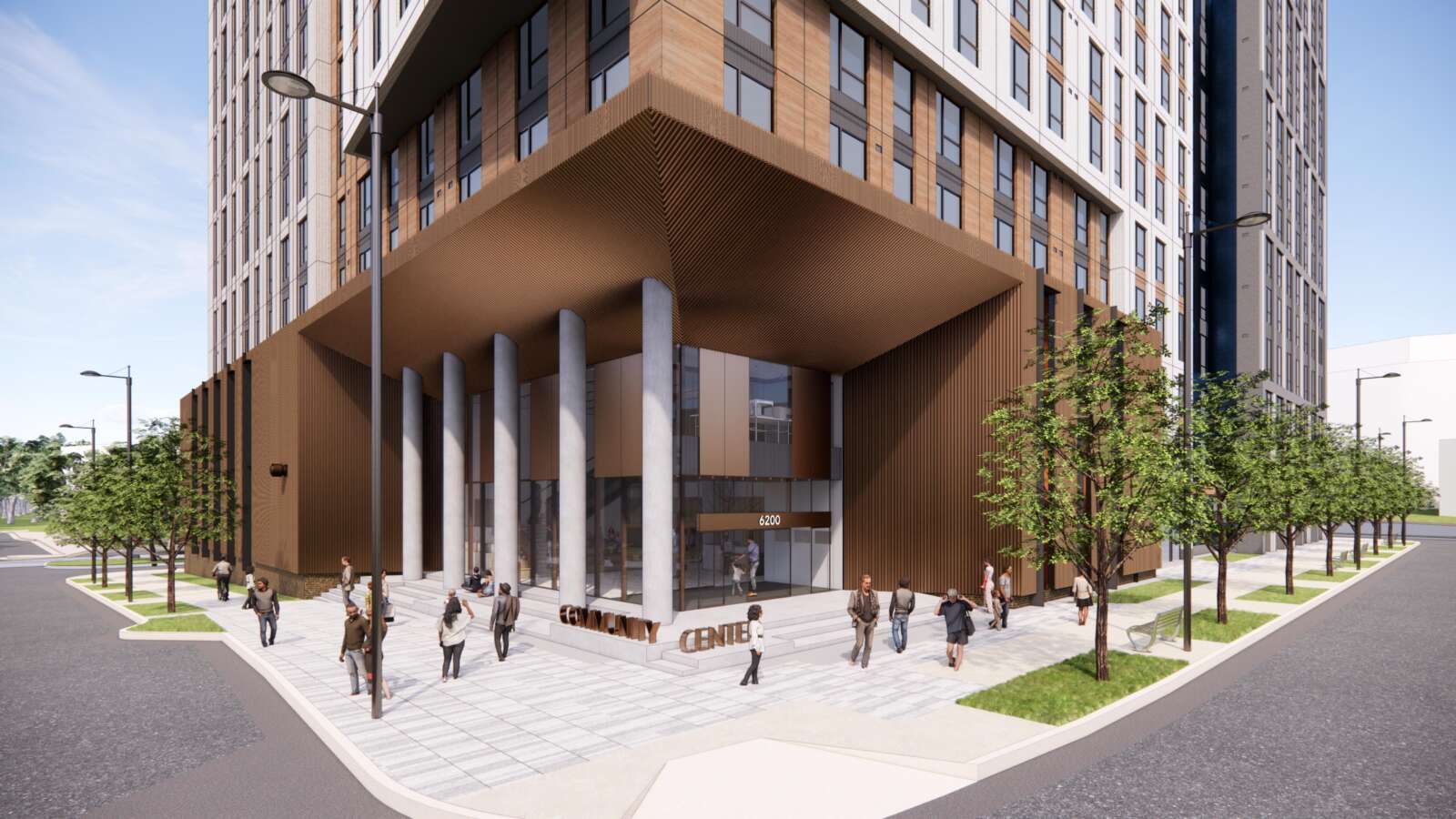
Fairfax County will sell bonds to finance the Tysons Community Center planned as part of the Dominion Square West housing project.
The Fairfax County Economic Development Authority was authorized by the Board of Supervisors last Tuesday (Oct. 10) to sell up to $43 million in facilities bonds to fund the community center, which has an estimated cost of $41 million.
The bond financing will also partially cover the county’s share of infrastructure costs, including the 75 parking garage spaces that will be designated for community center workers and visitors.
“This is a big step in this project,” Hunter Mill District Supervisor Walter Alcorn said Tuesday. “This community center was really important to attracting the funding from Amazon for this project. It’s going to be a really useful asset to the broader community, to that area. It’s certainly going to help make it a great place to live for future residents.”
Designed and built by the Arlington Partnership for Affordable Housing (APAH), the 30,000-square-foot, two-level community center will be located in one of two residential high-rises that the nonprofit developer is building at 1592 Spring Hill Road.
Planned amenities include a full-size gym, sensory and recreational spaces, meeting rooms, fitness rooms, a kitchen and a 1,900-square-foot outdoor courtyard. The center will be open to the general public as well as future Dominion Square West residents.
Replacing a parking lot next to the Jaguar and Land Rover dealership near the Spring Hill Metro station, APAH’s development will provide 516 residential units for households earning 30% to 70% of the area median income, which is currently $152,100 for a family of four in Fairfax County.
Funds for the project’s housing components and construction are coming from a range of sources, including a $55 million grant from Amazon, American Rescue Plan Act funds, developer contributions, and $10 million from the Fairfax County Redevelopment and Housing Authority (FCRHA).
According to a staff memo, the Department of Housing and Community Development expects to close on all project requirements, including housing bond financing, by mid-December.
As of this summer, APAH anticipated starting construction this December and completing the project in November 2027.
County staff said the community center will “provide social, recreational, health and wellness activities for older adults and youth” that are currently lacking in Tysons. Since July, the county has been offering some programs for teens and families through its Community Services Room at Tysons Corner Center.
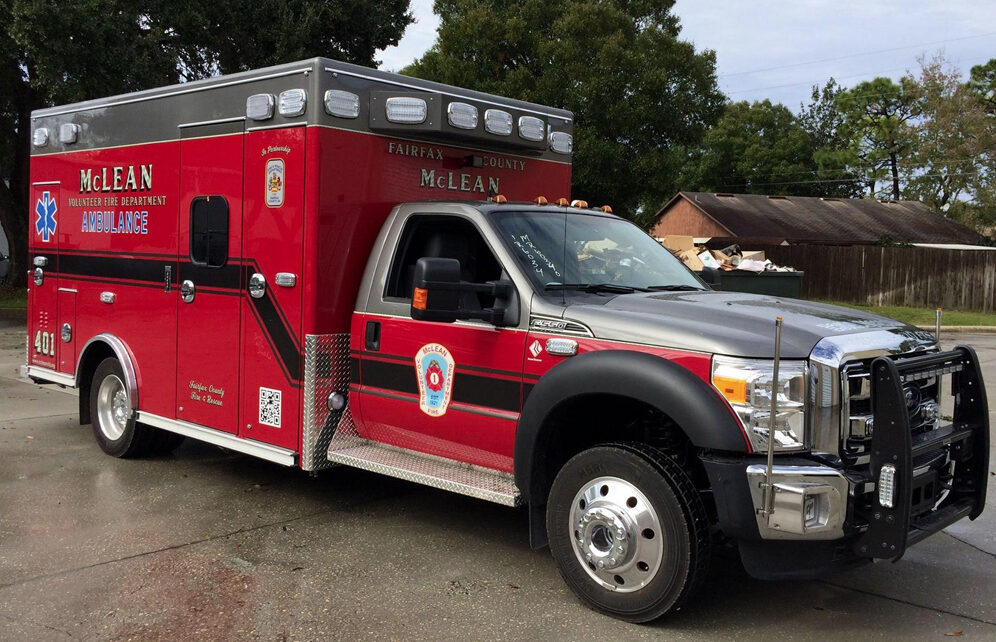
The McLean Volunteer Fire Department (MVFD) is a step closer to obtaining a brand-new ambulance.
The department got the Fairfax County Board of Supervisors’ unanimous approval on July 25 to borrow up to $250,000 from a private lender to buy fire and rescue equipment.
Federal tax law allows volunteer fire departments to obtain loans for fire and rescue equipment “at a lower tax-exempt interest rate” if the financing is approved by “the elected body of the locality” served by the department, county staff said in the board meeting agenda.
The loan will supplement a $13,000 donation that the MVFD got in June from the Woman’s Club of McLean, a charitable group that organized a Kitchen and Garden Tour this spring as a fundraiser for the department.
The department also raised funds through Christmas ornament sales and other activities to pay for the new ambulance, which will cost a total of $335,000.
MVFD currently has two ambulances. Department officials previously told FFXnow that the new “state-of-the-art” vehicle will have a power load cot system and other upgrades that will make it safer and easier to use for paramedics.
The ambulance is expected to arrive late this summer or early fall, MVFD President Patricia Moynihan said.
After acquiring the ambulance, the department hopes to get a new fire engine. The approximately $500,000 cost will be split between MVFD and the county.
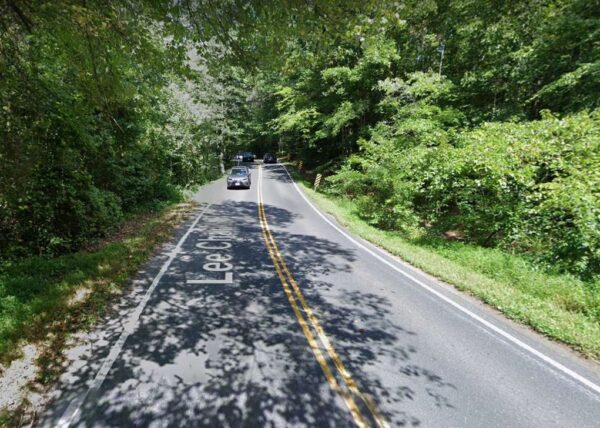
In the wake of a fatal crash earlier this year, Fairfax County intends to get rid of the hills that make Lee Chapel Road near Fairfax Station so harrowing to navigate.
Eliminating the two hills has emerged as “the most prudent” mid-term option for improving safety on the 1-mile stretch between Ox Road (Route 123) and Fairfax County Parkway, where two teens were killed and another seriously injured in a crash on Jan. 10, according to Springfield District Supervisor Pat Herrity.
To fund the project’s estimated $9 million cost, the Fairfax County Board of Supervisors directed staff today (Tuesday) to take away $5 million from the planned Shirley Gate Road extension, which is fully funded but not expected to start construction until 2026.
“They are both very important projects…but I think it’s critical we move forward with Lee Chapel safety improvements, and this allows that to happen,” Herrity said, noting that county staff have said the shift in funding won’t delay the Shirley Gate project.
The county is working with the Virginia Department of Transportation, Del. Kathy Tran, state Sen. George Barker and other partners to fund the remainder of the Lee Chapel project and “restore full funding to Shirley Gate as quickly as possible,” Herrity’s joint board matter with Board Chairman Jeff McKay and Mount Vernon District Supervisor Dan Storck says.
January’s fatal crash was the third on the scrutinized segment of Lee Chapel Road in less than 20 years, following deadly crashes in 2005 and 2015. The victims in all three crashes were teenagers.
Seeking to improve visibility for drivers, Herrity first proposed eliminating the hills in 2017 as part of a plan to widen the two-lane road to four lanes. The project was included in the county’s Transportation Priorities Plan (TPP) but got dropped after Virginia redirected regional transportation funds to Metro.
After January’s crash renewed calls for safety improvements from the community, VDOT and the Fairfax County Department of Transportation evaluated three options: remove both hills, remove just the larger hill or build the first leg of the Lee Chapel Road widening.
Removing both hills and constructing two 11-foot-wide travel lanes and a 6-foot-wide shoulder on each side of the road was “the alternative that appears to be the most prudent from a funding, timeline, and community support standpoint,” Herrity said.
“Only very preliminary design work has been done, so we are not at the level of design where we can say to what extent private and public property would be impacted, including trees,” Herrity’s office told FFXnow, noting that the $9 million cost estimate assumes VDOT will allow Lee Chapel to be fully closed during construction.
The proposal will be presented to the public at a town hall meeting with Tran and Barker in September, though the exact date hasn’t yet been settled. Read More
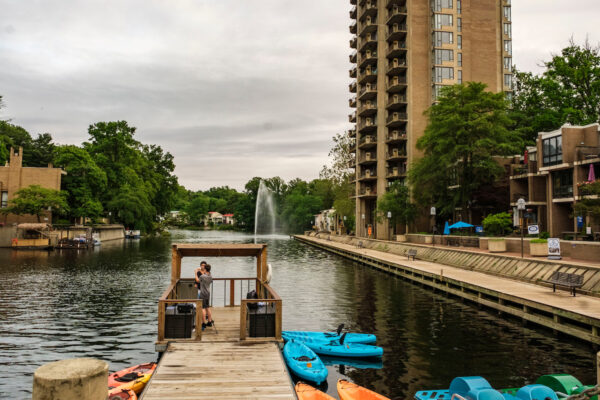
(Updated at 5 p.m.) The final phase of the economic visioning of the Lake Anne area is nearing.
At a meeting today (Tuesday), the Fairfax County Board of Supervisors opened up a request for an additional $200,000 for the third phase of the project.
Consultant Street Sense is wrapping up the first phase of the Economic Visioning Study for the Lake Anne Commercial Revitalization Area. The study intended to build community consensus on a path forward for the area.
(Correction: This story previously said the study’s first phase wrapped up this spring, as indicated by a project timeline, but the Hunter Mill District office says it’s just now finishing.)
“We sought an economic vision that was aspirational, grounded in market realities, and able to strengthen the economic viability and sustainability of the area,” Hunter Mill District Supervisor Walter Alcorn wrote in his board matter. “There was extensive participation by the Lake Anne community to shape the economic vision through a combination of focus groups, an online survey, and several in-person workshops and meetings.”
So far, the plan suggests a concentration of new apartment units on the Crescent property at 1527 Cameron Crescent Drive, added cultural attractions, a parking structure, a centralized green space, connections from the Crescent site to Lake Anne Plaza via a new park, and the restoration of a tunnel to the east side of the area.
Street Sense kicked off the visioning study in mid-February with focus group sessions, followed by several community meetings and workshops. The study came at the request of Alcorn, who sought to build consensus on the economic vision for the area.
In the second phase of the project, Streetsense will work with individual property owners and determine their willingness to take part in implementing the economic vision.
During the final phase, Streetsense and sub-consultants will investigate options for implementation in a more comprehensive manner.
“This information will provide landowners and the county with a clear understanding of options and allow all stakeholders to construct an actionable plan for realizing the economic vision,” the board matter states.
The final phase is expected to kick off in the first quarter of next year. The funds could be allocated this fall via a carryover adjustment from the fiscal year 2023 budget.
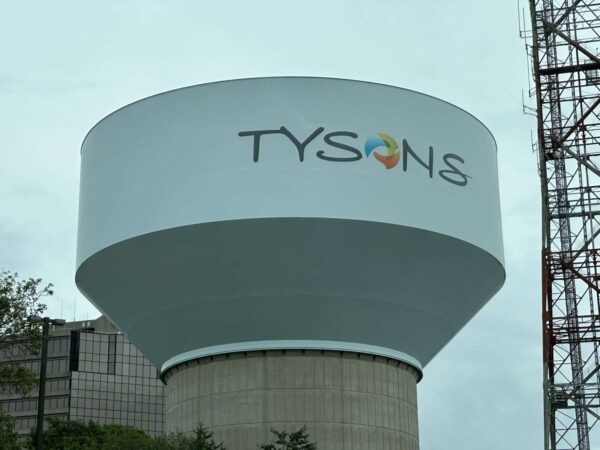
Fairfax County formalized its partnership with the Tysons Community Alliance earlier this week with a new agreement outlining the community improvement organization’s mission and structure.
Under the memorandum of understanding (MOU) approved by the Fairfax County Board of Supervisors on Tuesday (July 11), the TCA will turn to the county as a primary funding source going forward, even though it will operate independently as a nonprofit.
Tasked with promoting and advocating for Tysons as a community, the alliance will request funding through the county’s annual budget process, but the county has no obligation to fulfill the requests.
The group will also seek supplemental support from grants and “alternative revenue streams,” according to the agreement.
The unique financing model will require the TCA “to show our continued value” not only to Tysons, but also the county as a whole, CEO Katie Cristol told FFXnow in a recent interview. She assumed her position as the organization’s first permanent CEO on July 5.
“There are a lot of competing interests and needs throughout the county,” Cristol said. “…In literal dollars and cents terms, it’s a reinvestment back in Tysons so Tysons can keep delivering even more revenue for the good of the county, but it also, we hope, is going to generate some of these lessons learned that others will benefit from.”
Established last fall with $2.5 million in county funding, the TCA is responsible for implementing the county’s vision for Tysons as a downtown community where people live and work, not just a collection of offices and malls.
As outlined in the MOU, the group’s priorities will be communications and marketing, placemaking, research and business support, and transportation and mobility, including support for infrastructure improvements.
Some of that work is already underway, from community events to an ongoing strategic planning effort. Later this month, the TCA is expected to release an economic market study with data that could help it make the case that Tysons is a worthy investment for the county.
At a Board of Supervisors economic initiatives committee meeting last month, TCA Board of Directors Chair Josh White reported that Tysons brings in 8% of the county’s tax revenue.
“Can we take a small, small share of that and reinvest it back into the Tysons to support that overall growth?” Cristol said. “So, that was part of the idea, and the [TCA] governance is built around really giving government a strong voice.”
Cristol says the local government’s closer involvement separates TCA from similar nonprofit organizations that are typically supported by property or business owners, such Arlington’s business improvement districts.
In addition to potentially providing funding and having representatives on the TCA’s board of directors, the county will require annual reports from the alliance and collaborate on initiatives like public space enhancements, according to Providence District Supervisor Dalia Palchik, who represents much of Tysons.
Hunter Mill District Supervisor Walter Alcorn, whose district includes a western portion of Tysons, said he had hoped to see the TCA integrated with the existing Tysons Transportation Service District when it comes to funding road, sidewalk and other transportation projects.
“There’s still some work to be done to integrate those two concurrent activities,” he said at the board meeting.
The service district, which is funded by an annual tax on property owners, could complement the TCA’s funding for those projects, but the money won’t necessarily go directly to the alliance, according to Cristol.
Scott Sizer, a division manager in the county’s Department of Economic Initiatives, said the MOU was “written broadly to accommodate any future changes.”
“We hope it is a pilot that will be successful and will lead to other pilots in the county, but there is always a possibility to amend and to terminate,” Palchik said. “An MOU is a legal document, but I think it’s important that we be able to monitor [the TCA’s activities] and continue to ensure and hopefully see success.”
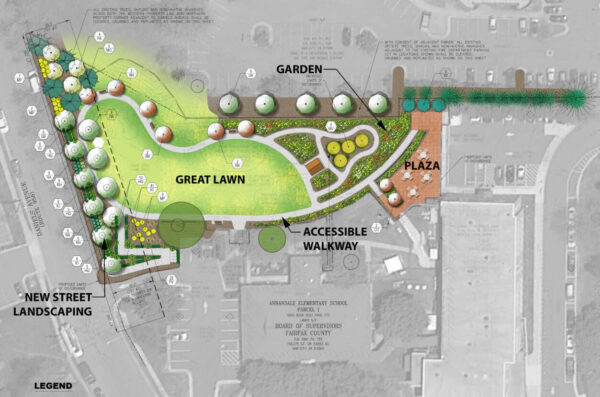
Construction is well underway on Annandale’s new civic space, but it will take a little more money to bring Fairfax County’s full vision to fruition.
The cost of the project, which will turn a parking lot at 7200 Columbia Pike into an urban park, has exceeded the available funding, leading to some elements getting revised or eliminated, Mason District Supervisor Penny Gross told the Board of Supervisors yesterday (Tuesday).
Gross requested that the county consider providing an additional $100,000 so those elements, including lighting and parking lot changes, can be reincorporated.
“While the project could be completed as-is, I believe strongly that the inclusion of certain design elements…would position the park for greater visitor safety and long-term success,” Gross said. “Pursuit of these elements during a subsequent phase of construction would contribute positively to the park’s visibility, connectivity, and ability to serve as an anchor for civic connection in an important revitalization area.”
In the works since 2018, the Annandale Civic Space will transform the county-owned site with a plaza, a green lawn with a “topography” playground, an educational garden and an accessible walkway linking Daniels Avenue to Columbia Pike.
Currently, construction is on track to finish this fall, according to the Department of Planning and Development’s community revitalization section.
Initially, the county estimated a “ballpark cost” of $600,000 to $650,000, DPD staff said at a community meeting in 2021. However, by the time construction began this past March, the total estimate had grown to $700,000, according to the DPD’s project page.
Lighting along the walkway through the park and enhancements to the parking lot shown in the final design concept in 2019 were dropped from an updated rendering approved in July 2022.
If approved, the additional funding will primarily go toward realizing the county’s vision of the parking lot as a pop-up programming and events space, according to Gross.
“As the project evolved, designers saw an opportunity to utilize excess parking lot surface by shifting some of the parking spaces to install a more direct sidewalk construction and landscaping panel from the plaza area to the public sidewalk along Columbia Pike,” she told FFXnow. “Funds for Phase 2 also would implement the envisioned catenary lighting, reseal and repaint the parking lot, and install bollards around the refuse collection pad to ensure the bins remain in their proper location.”
During business hours, the lot is expected to provide parking for the Annandale Christian Community for Action (ACCA) Child Development Center, which operates out of the former Annandale Elementary School building on the site.
Gross said the project has “required creativity and flexibility,” including when it came to financing. Since 2020, the county has assembled funds for construction from a variety of sources, including a $363,250 environmental improvement program grant and Economic Opportunity Reserve funds.
At Gross’s request, the project will now be considered for funding from the county’s fiscal year 2023 carryover review, an annual process that allocates any leftover money from the previous fiscal year.
The county’s fiscal year ends on June 30, so the Board of Supervisors typically approves the carryover package in the fall.

Fairfax County hopes to make use of American Rescue Plan funding to help provide housing for some of those most in need.
In a meeting of the Board of Supervisors Housing Committee last week, staff from the Department of Housing and Community Development said a tranche of federal funding could help local residents in more extreme levels of poverty than most affordable housing programs in the county assist.
“This is a rare funding opportunity specifically targeted to reducing homelessness and can serve populations at the extreme low end of the spectrum,” said Thomas Barnett, deputy director of the Office to Prevent and End Homelessness. “This provides not just housing, but money for supportive services that we know people need.”
Fairfax County was awarded $7.88 million from the U.S. Department of Housing and Urban Development (HUD).
According to the presentation to the committee:
HOME-ARP funds must be used to primarily benefit individuals or families from the following qualifying populations:
- Homeless
- At risk of homelessness
- Those fleeing, or attempting to flee, domestic violence, dating violence, sexual assault, stalking, or human trafficking
- Other families requiring services or housing assistance to prevent homelessness
- Households at greatest risk of housing instability
Barnett said there are around 88 permanent supportive housing projects in the pipeline that the nearly $8 million in federal funding could go toward. The funding comes as Fairfax County deals with an uptick in people experiencing homelessness, caused in large part by the pandemic and related economic turmoil.
“Chronic homelessness has increased disproportionately during the pandemic,” Barnett said. “[It’s] up 34% in the last 5 years.”
Even within that category, some supervisors said they’d like to see funding targeted specifically on addressing youth homelessness. The most recent Point-in-Time Count — a survey of people experiencing homelessness in the span of one night — found 91 people between the ages of 18-24 experiencing homelessness in Fairfax County.
“We have, as you point out, a rare funding opportunity with a big infusion of funds,” Board Chairman Jeff McKay said. “I’m still troubled by, when we get that Point-in-Time Count, that homeless youth count…I would like more information coming back as to what strategies we might employ to help with that, to use this rare opportunity funding to solve what we know is always a difficult thing to work with under normal circumstances, can any of this be used to accelerate that.”
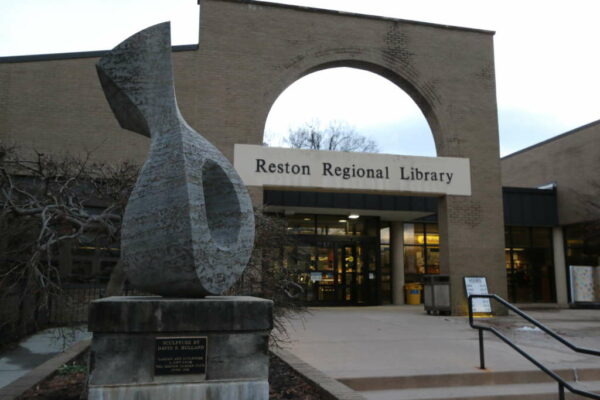
The Friends of Reston Regional Library (FRRL) is celebrating Fairfax County Public Library’s theme for 2022 — the year of literacy — with a record-setting gift.
The nonprofit organization, which has been supporting the Reston library since 1985, is providing a grant of $200,000 to the county library system to expand its printed and digital materials for the library collection.
According to Eileen Evon, a spokesperson for FRRL, this is the largest single gift the organization has ever given to FCPL.
“The gift will give a much needed boost to the library’s ability to add more copies of popular titles already in the catalog, while also expanding the depth and breadth of many subject areas, including fiction for all ages, as well as non-fiction books, bi-lingual books, and books in other languages for young readers,” FRRL said in a news release.
FRRL issued the following statement regarding the gift:
The truth is, between the hard wear and tear on highly circulated print materials, the increased demand for digital materials, and the increase in total checkouts and library card holders, the County budget to the Library for collections just hasn’t caught up to the need. We know they are reviewing this and hope that it will change in the future as the library system continues to grow and change.
In the meantime, we thought the Year of Literacy was the perfect time for us to call public attention to this pressing need, and pitch in ourselves with the monies generated — one book at a time — by our hardworking volunteers who sort and sell books and media from over 40 tons of donated materials each year. After talking with Director Hudson and the head of Technical Operations, Dianne Coan, we know the Collections Development team will work hard to make the most out of every dollar to strengthen and expand the collection to best serve all of its patrons.
The gift will be formally handed over in a ceremony on June 8 at an FCPL Board of Trustees meeting. FCPL director Jessica Hudson, the board, Hunter Mill District Supervisor Water Alcorn, and other local officials plan to attend.
The Friends are also providing one-time grants to local organizations in an effort to support and promote literacy in the community. Grants range from $5,000 to $50,000 and will be awarded to a group that provide hands-on programming that directly impacts literacy in Reston, Herndon, and the county overall.
The news comes as FRRL positions itself to support the creation of a new library for Reston — which has been contemplated for several years. While county voters approved a bond in 2012 to fund the project, FRRL president Brian Jacoby noted that more funds may be needed.
“Every branch has its own unique requirements to best support its staff, volunteers, and patrons,” Jacoby wrote in statement. “New furniture, materials and equipment, or facilities space specific to the needs of our local community may not be covered by either the developer’s plans or the County’s funding. Our volunteers and our patrons are long-time active users of the Reston branch and they have a strong love for the library and what it provides to our community.”
The Friends’ board recently affirmed its commitment to set aside savings for needs related to the future building.

